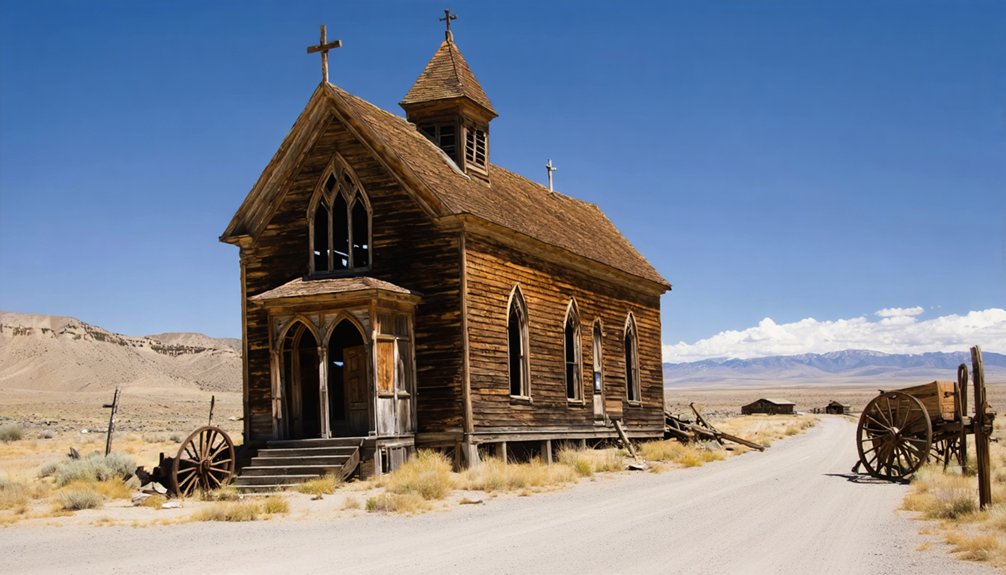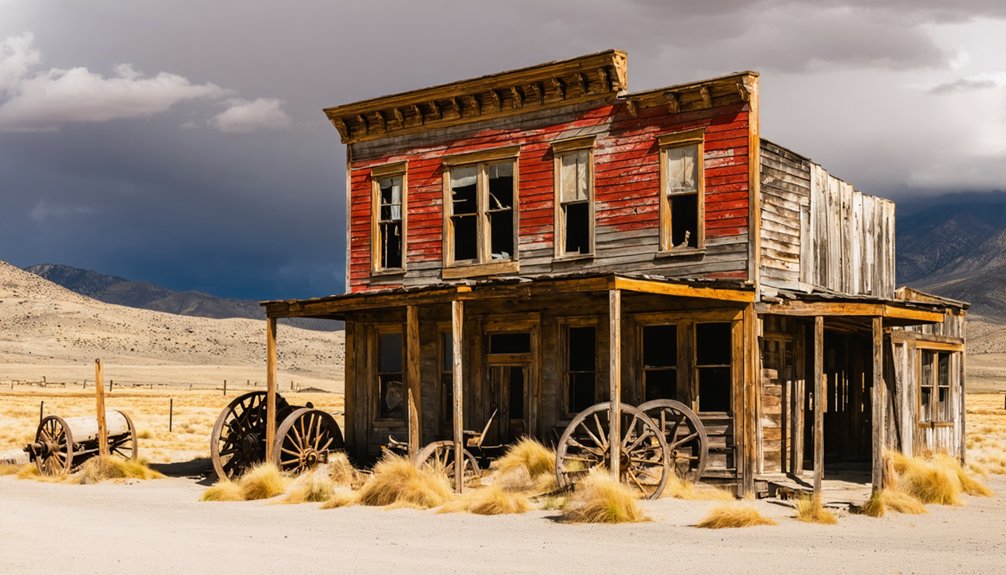You’ll find America’s creepiest ghost towns frozen in various states of abandonment, from Centralia’s perpetually burning underground fires to Bodie’s perfectly preserved gold rush saloons. Gary’s skeletal Gothic churches stand as haunting monuments to industrial collapse, while St. Elmo’s mountain mining structures remain eerily intact. These forgotten places offer chilling glimpses into interrupted lives, where nature reclaims human ambition and whispers of the past linger in the silence.
Key Takeaways
- Centralia, Pennsylvania has endured a hellish underground fire for 60+ years, driving away residents with toxic gases and dangerous sinkholes.
- Bodie, California maintains over 100 original structures in “arrested decay” with untouched artifacts providing an authentic Wild West ghost town experience.
- Gary, Indiana’s abandoned City Methodist Church stands as a haunting Gothic ruin symbolizing industrial collapse after once serving 3,000 congregants.
- St. Elmo, Colorado preserves 43 original structures from its mining heyday, designated as a National Historic District known for its haunting charm.
- Rhyolite, Nevada boasted electricity and an opera house during its brief boom before becoming one of America’s most dramatic ghost town ruins.
The Burning Underground of Centralia, Pennsylvania
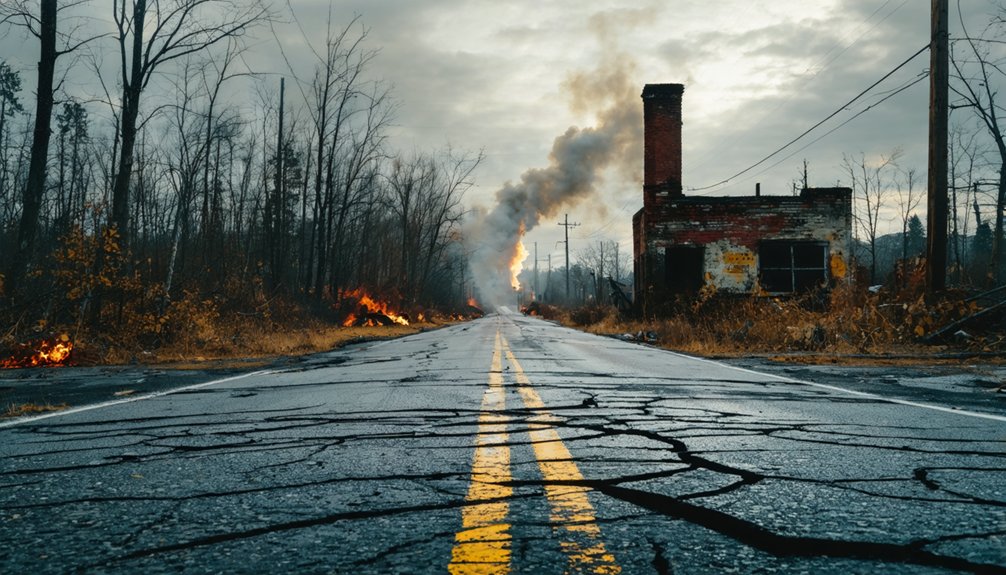
Beneath the cracked asphalt and forgotten streets of Centralia, Pennsylvania, a hellish inferno has been silently devouring the earth for over six decades.
What you’re witnessing isn’t folklore—it’s the consequence of a 1962 landfill fire that ignited coal seams running 300 feet deep beneath the town.
You’ll feel the eerie warmth rising from the ground as you explore this modern ghost town, once home to 1,500 residents, now inhabited by fewer than 10 souls.
The fire’s toxic gases and dangerous sinkholes rendered basic fire safety impossible, forcing a mass evacuation.
The invisible destroyer beneath made survival untenable, leaving a once-vibrant community with no choice but exodus.
Lethal carbon monoxide and other deadly gases permeate the area, creating an environment that’s completely inhospitable to human life.
As you wander past demolished homes and steam-venting earth, you’re walking above an environmental consequence that continues to spread 75 feet annually.
The underground blaze could burn for another 250 years—a haunting monument to industrial neglect.
Despite several intervention attempts, including the use of wet sand techniques to cut off oxygen supply, officials failed to extinguish the persistent underground fire.
Bodie: California’s Frozen-in-Time Mining Settlement
When you step into Bodie State Historic Park, you’re walking through a genuine time capsule where homes still contain dishes on tables, clothes in closets, and goods on store shelves from when residents hastily departed.
California’s commitment to “arrested decay” preservation means nothing is restored or reconstructed—instead, buildings are maintained exactly as they were found, slowly weathering under the harsh mountain elements.
The area earned quite a reputation in its heyday, with the phrase “Badman from Bodie” becoming synonymous with the town’s notorious inhabitants.
You’ll find over 100 original structures still standing in this official state gold rush ghost town, from the stamp mill where gold was processed to the church where residents sought redemption amid the town’s notorious violence. The town’s population once reached over 10,000 residents during its peak in 1880, before a series of disasters and economic decline led to its abandonment.
Daily Life Preserved
Unlike most abandoned towns that crumble into forgotten dust, Bodie stands as a perfectly preserved time capsule where life seems to have simply paused mid-sentence.
As you wander through the weathered buildings, you’ll glimpse historical artifacts exactly as residents left them—coffee still in the grinder, clothes hanging by the stove, schoolbooks open on desks. The mining lifestyle unfolds before your eyes in extraordinary detail, from saloon poker tables to the tools of daily labor. This historical site serves as one of many place names associated with Bodie in reference materials. With up to 65 saloons at its peak, Bodie embodied the wild spirit of gold rush boomtowns.
What makes Bodie eerily enchanting is its “arrested decay” status—nothing restored, nothing removed.
Tables remain set for dinner never served, and store shelves still display goods never purchased. This frozen moment reveals the harsh reality of frontier life while allowing you to walk freely through an authentic piece of Wild West history.
Park Preservation Efforts
Since becoming a California State Historic Park in 1962, Bodie has embraced a preservation philosophy that’s both radical and reverent—”arrested decay.”
You won’t find polished restorations or reconstructed buildings here; instead, park officials meticulously maintain the town exactly as it was found, performing only the minimal repairs needed to prevent structures from collapsing entirely.
The Bodie Foundation, a passionate non-profit partner, spearheads preservation techniques that honor authenticity above all.
Their “Save Bodie” campaign targets at-risk structures with emergency stabilization while leaving the weathered patina untouched. The Foundation achieved 501(c)(3) status in 2009, allowing them to better support preservation efforts through tax-deductible donations. Preservation teams face significant challenges due to the harsh weather conditions at the site’s 8,375-foot elevation.
Community involvement runs deep—volunteers and donors provide critical support, knowing that if a building falls, it stays fallen.
This uncommon approach guarantees you’ll experience a genuinely haunting glimpse into the past, unsanitized and powerfully real.
The Abandoned Churches of Gary, Indiana
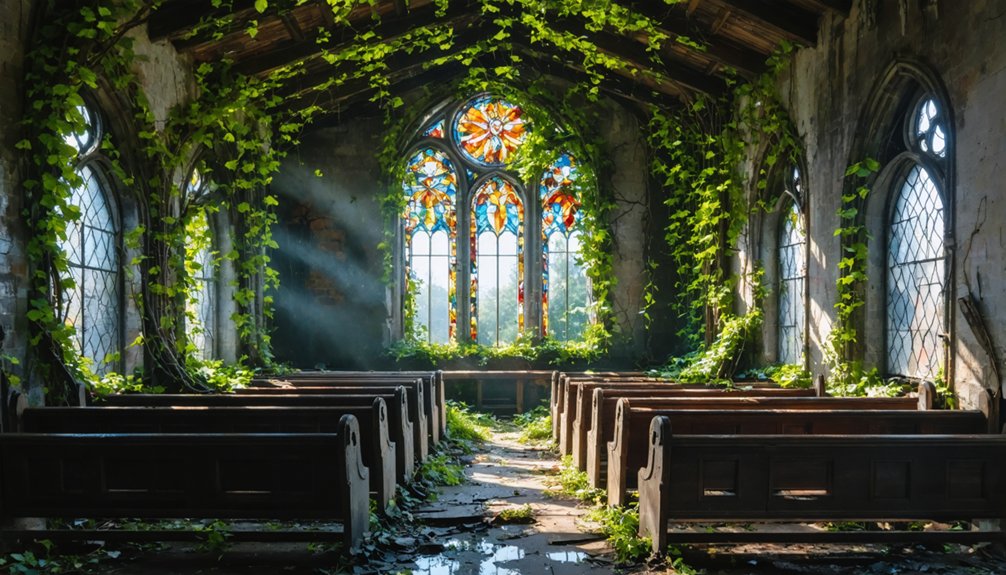
As you wander through Gary’s haunting cityscape, the magnificent Gothic spires of City Methodist Church rise like skeletal fingers against Indiana’s gray skies. Its crumbling walls and stained glass fragments now serve as canvas for urban explorers and photographers.
Once home to 3,000 faithful congregants during the 1950s steel boom, this $800,000 architectural marvel now stands as a poignant symbol to both industrial collapse and unwavering faith that once flourished amid these now-silent corridors.
The church’s massive nine-story complex, with its theater, gymnasium, and grand halls now blanketed in graffiti and climbing vines, captures the bittersweet beauty of abandonment that makes Gary’s ecclesiastical ruins among America’s most hauntingly photogenic ghost town locations. A devastating fire in the 1990s accelerated the decay of this once-vibrant community centerpiece, leaving behind the hauntingly beautiful ruins we see today. There are discussions to transform this decaying landmark into a ruin garden park similar to historic sites in London, offering a path toward preservation rather than demolition.
Gothic Ruins Reclaimed
Rising like a Gothic apparition amid Gary’s industrial decay, the Methodist Church on Washington Street stands as a haunting tribute to the city’s bygone glory days.
Once America’s largest Methodist congregation, this English Gothic Revival masterpiece now silently watches over a changing landscape, its $14 million modern-equivalent structure slowly surrendering to nature’s embrace.
- Built in 1927 with U.S. Steel funding when Gary was a thriving industrial hub
- Housed 3,000 members at its peak, with impressive gothic architecture despite serving working-class communities
- Abandoned in 1975 after city’s economic collapse, now features in horror films
- Proposed transformation into a “ruin garden park” inspired by London’s St. Dunstan-in-the-East
- Represents both the rise and fall of American industrial might and community resilience
Urban Decay Photography
Through broken stained glass windows where sunlight creates ghostly patterns on crumbling plaster, Gary’s abandoned Methodist Church has become an unlikely canvas for urban decay photographers.
Once the Midwest’s largest Methodist church, this nine-story Gothic Revival structure now stands as a haunting indication of America’s industrial decline.
Urban exploration permits grant you access to photograph ivy cascading through shattered windows and the collapsed roof that frames Indiana’s sky.
The juxtaposition of ornate architecture against raw decay offers compelling architectural photography opportunities that have attracted Hollywood filmmakers.
As you capture the sagging choir loft and graffiti-covered walls, you’re documenting more than just a building—you’re preserving the visual history of economic upheaval, white flight, and the harsh reality of post-industrial America.
Faith Amid Abandonment
The skeletal remains of City Methodist Church stand as Gary, Indiana’s most haunting monument to faith abandoned. Once the spiritual home to over 3,000 worshippers and funded by steel industry titans, this $800,000 English Gothic masterpiece now crumbles silently.
You’ll find its nine-story skeleton hauntingly beautiful, with sunlight streaming through empty window frames where stained glass once filtered divine light.
- Towering arches reach skyward like hands in desperate prayer
- Film crews capture its decay in horror movies, finding beauty in abandonment
- Progressive leadership once defied segregation, now echoing in empty halls
- Architectural preservation efforts clash with safety concerns
- Some whisper of faith revival possibilities in this sacred ruin
Where corporate wealth once fueled religious fervor, only urban explorers worship now.
St. Elmo: Colorado’s Well-Preserved Mountain Ghost Town

Nestled deep within Colorado’s majestic Chalk Creek Canyon, St. Elmo stands frozen in time, offering you a hauntingly authentic glimpse into America’s mining heritage.
Once thriving with nearly 2,000 souls during the gold and silver boom, this mountain settlement now whispers tales through its 43 remarkably preserved original structures.
You’ll feel the ghostly legends come alive as you stroll past the historic general store and hotels where “Dirty Annie” Stark allegedly still roams.
The Mary Murphy Mine once yielded $60 million in gold before the 1922 closure that triggered the town’s demise.
A $60 million fortune extracted from mountain depths, then silence—the Mary Murphy Mine’s legacy echoes through abandoned St. Elmo.
Designated a National Historic District in 1979, St. Elmo’s eerie charm beckons freedom-seeking explorers.
Surrounded by rugged mountain trails and rushing Chalk Creek waters, it remains Colorado’s most atmospheric—and reportedly most haunted—ghost town.
The Haunting Ruins Along Route 61
Winding along America’s eastern seaboard, Route 61 harbors some of the nation’s most chilling abandoned landscapes, none more infamous than Centralia, Pennsylvania—where hell literally broke through earth’s crust.
You’ll find an underground coal fire that’s been burning since 1962 and will continue for centuries, creating a post-apocalyptic wasteland where few dare to live permanently.
- The legendary “Graffiti Highway,” once a kaleidoscope of unauthorized Abandoned Art, now lies buried under dirt since 2020
- Poisonous gases still seep through fractures in the earth, with warning signs dotting the ghostly landscape
- Dangerous sinkholes appear without warning, swallowing portions of the route
- Remnants of bypassed sections create eerie time capsules throughout Minnesota
- Former landmarks like the allegedly haunted Community National Bank stand as silent sentinels to the road’s dark history
Goldfield: Nevada’s Fire-Ravaged Gold Rush Town

Once Nevada’s golden child and the state’s largest city during the early 1900s, Goldfield now stands as a haunting memorial to boom-and-bust cycles that defined America’s western frontier.
Walking these streets, you’ll feel the echoes of a mining legacy that extracted over $86 million in gold—worth billions today.
The elegant Goldfield Hotel, with its brick façade that miraculously survived the catastrophic 1923 fire, towers over what remains.
That blaze, sparked by a moonshine still explosion, devoured dozens of blocks and accelerated the town’s decline.
Before then, Goldfield’s opulent brownstones and saloons had replaced humble tents, attracting celebrities and fortune-seekers alike.
Today, fewer than 300 souls inhabit this living ghost town, where paranormal enthusiasts seek spirits among ruins that whisper tales of lost fortunes.
Urban Decay in America’s Rust Belt Ghost Cities
While Goldfield represents the classic Western ghost town, America’s Rust Belt cities tell a more recent and perhaps more disturbing tale of abandonment.
Once-thriving industrial giants like Detroit, Cleveland, and Buffalo now stand as monuments to economic despair, their crumbling facades whispering stories of prosperity lost to time.
- Entire neighborhoods sit vacant, with houses available for less than the price of a dinner.
- Nature slowly reclaims abandoned factories where thousands once earned living wages.
- Urban blight spreads like a contagion, with over 40% population loss in major industrial centers.
- Abandoned bowling alleys and malls create eerie playgrounds of consumer ghosts.
- Racial divisions carved into the landscape remain visible in patterns of abandonment.
You’ll find a haunting beauty in these decaying urban landscapes—physical manifestations of American dreams deferred.
Desert Ghost Towns of the American Southwest
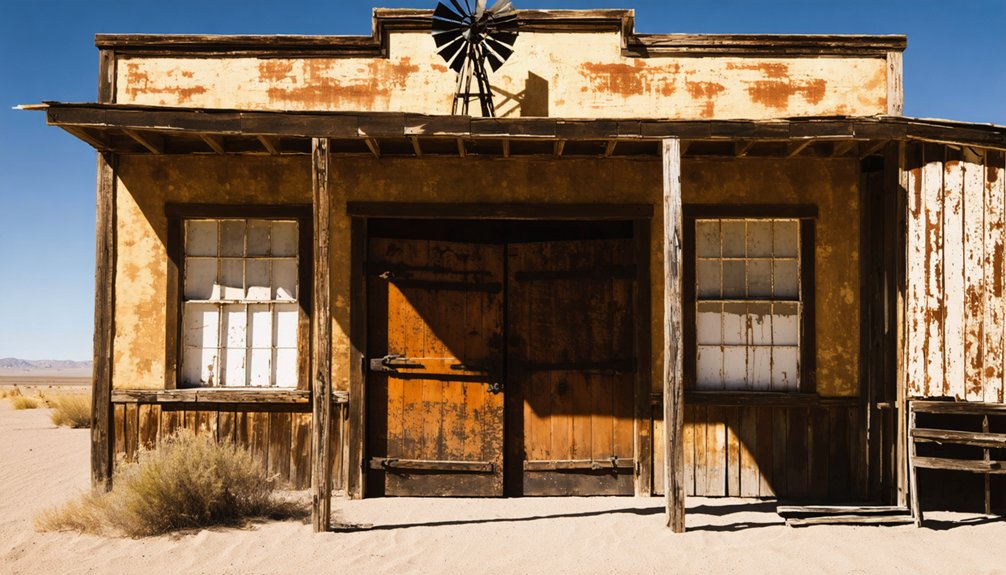
Beneath the scorching sun of America’s Southwest, ghost towns stand frozen in time, their weathered wooden facades and crumbling brick structures telling tales of boom-and-bust cycles that defined the region’s mining era.
You’ll find places like Bodie, California, with its 60 saloons frozen in “arrested decay,” or Arizona’s Gleeson, where the old jail still whispers stories of frontier justice. These settlements flourished wildly, then vanished almost overnight when the precious metals disappeared.
Once-bustling Rhyolite had electricity and an opera house before abandonment claimed it by 1920.
Today, ghost town tourism transforms these desert relics into portals to our past. As you wander through Jerome or Ruby, you’re not just exploring mining history—you’re walking the same dusty streets where fortunes were made and dreams shattered beneath the unforgiving desert sky.
Frequently Asked Questions
Are Ghost Towns Legally Accessible for Urban Explorers?
In Bodie, California’s dusty saloons, you’ll discover urban exploration’s reality: ghost towns have legal restrictions. Public sites welcome your wandering spirit; private ones require permission or you’re simply trespassing.
What Safety Hazards Exist in Abandoned Mining Ghost Towns?
You’ll face collapsing hazardous structures, toxic heavy metals, and deadly gas pockets. Hidden mine shafts beckon with eerie whispers while environmental dangers lurk beneath weathered wood and rusting metal relics.
Can You Purchase Property in America’s Ghost Towns?
Despite their eerie reputation, you can absolutely secure property ownership in America’s ghost towns. From desert saloons to mountain mining outposts, these freedom-filled ghost town investments await your transformative vision.
Which Ghost Towns Have Reported Paranormal Activity?
You’ll discover haunted locations across America where spirits linger – Bodie with its cursed artifacts, Bannack’s blue-gowned Dorothy, Silver City’s flying objects, and Connecticut’s Bara-Hack echo with supernatural legends of the past.
Do Any Ghost Towns Still Maintain Working Utilities?
You’ll find ghost towns with working utilities maintenance where residual populations exist. These places maintain ghost town infrastructure for tourism or caretakers, offering glimpses of life amidst haunting abandonment and weathered facades.
References
- https://247wallst.com/special-report/2018/11/02/30-american-ghost-towns-3/
- https://themortgagepoint.com/2024/10/25/americas-new-ghost-towns/
- https://www.loveexploring.com/gallerylist/188219/the-us-state-with-the-most-ghost-towns-revealed
- https://www.youtube.com/watch?v=9sqf1Ayk3N0
- https://www.geotab.com/ghost-towns/
- https://en.wikipedia.org/wiki/Lists_of_ghost_towns_in_the_United_States
- https://joybird.com/blog/top-ghost-towns-in-america/
- https://worldpopulationreview.com/world-city-rankings/abandoned-cities
- https://en.wikipedia.org/wiki/Centralia_mine_fire
- https://www.britannica.com/video/coal-mine-fire-Pennsylvania-Centralia/-207717
